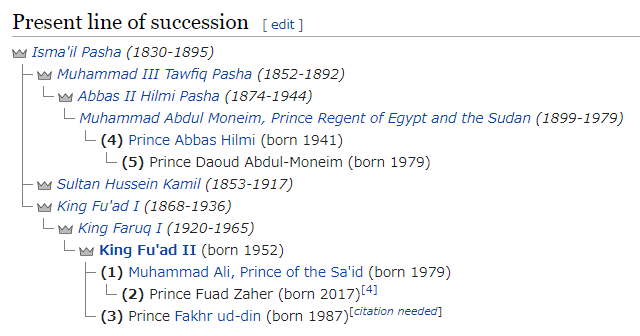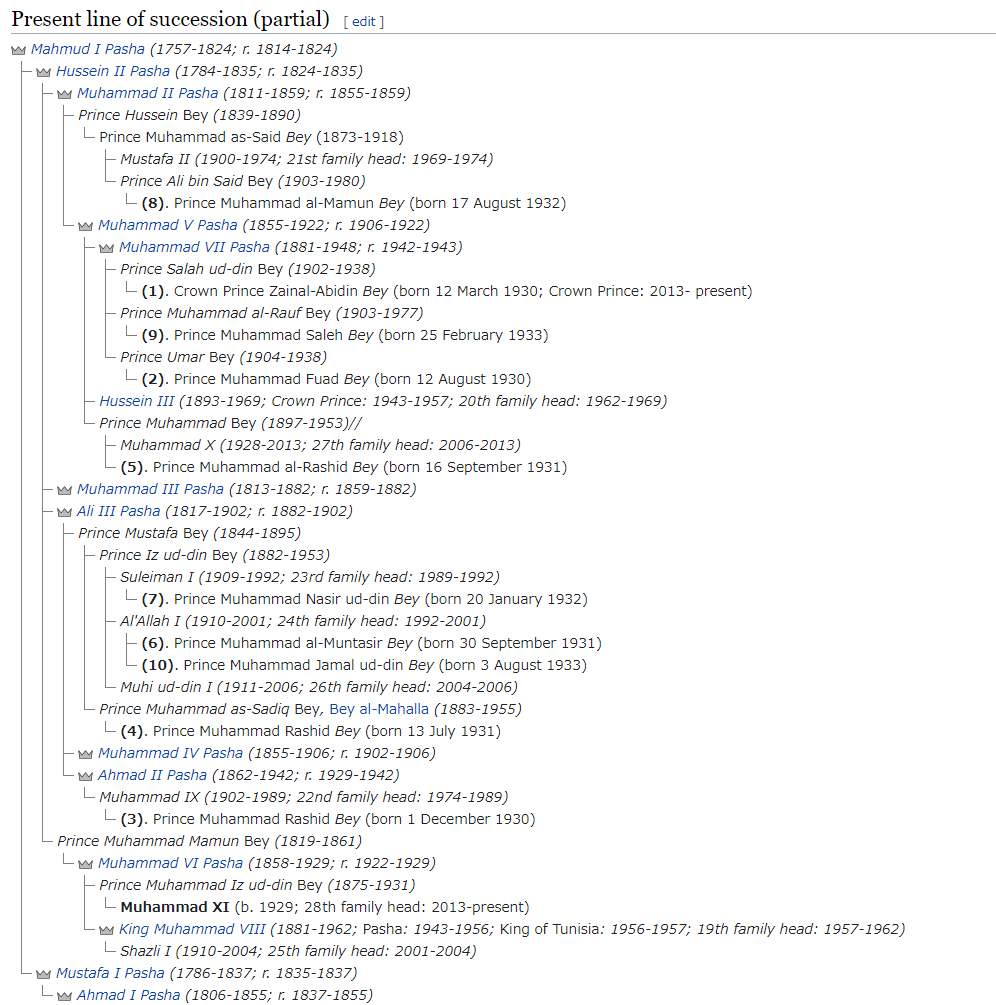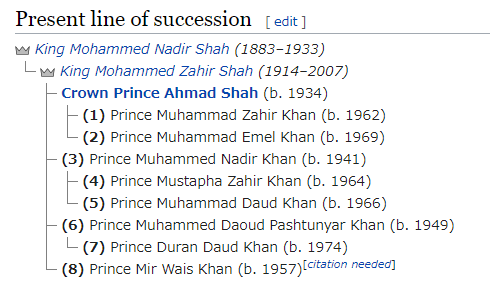note:
As of July 2020.
Under the Muhammad Ali dynasty, the line of succession to the former Egyptian throne was subject to a number of changes during its history. From its founding in 1805 until 1866, the dynasty followed the imperial Ottoman practice of agnatic seniority, whereby the eldest male in any generation would succeed to the throne. In 1866, however, the then Khedive of Egypt Isma’il Pasha obtained a firman from the Ottoman Emperor which restricted the succession to the male-line descendants of Isma’il Pasha. The resulting succession remained in force until the abolition of the Egyptian monarchy in 1953, following the 1952 Egyptian Revolution.
In 1914, however, the British government deposed Khedive Abbas II, the senior descendant of Isma’il, and proclaimed a protectorate over Egypt. His son Muhammad Abdel Moneim lost his place as heir apparent,[1] and the throne passed to the lines of Abbas II’s uncles Hussein Kamel and Fuad I. A Royal Edict of 13 April 1922 specifically excluded Abbas II from the succession, though it stated that “this exception shall not apply to his sons and their progeny.”[2] As a result, the descendants in the male line from Prince Muhammad Abdel Moneim remained eligible for the throne and retained a senior position in the order of precedence of the Kingdom of Egypt.[3]
Present line of succession
- Isma’il Pasha (1830-1895)
- Muhammad III Tawfiq Pasha (1852-1892)
- Abbas II Hilmi Pasha (1874-1944)
- Muhammad Abdul Moneim, Prince Regent of Egypt and the Sudan (1899-1979)
- (4) Prince Abbas Hilmi (born 1941)
- (5) Prince Daoud Abdul-Moneim (born 1979)
- (4) Prince Abbas Hilmi (born 1941)
- Muhammad Abdul Moneim, Prince Regent of Egypt and the Sudan (1899-1979)
- Abbas II Hilmi Pasha (1874-1944)
- Sultan Hussein Kamil (1853-1917)
- King Fu’ad I (1868-1936)
- King Faruq I (1920-1965)
- King Fu’ad II (born 1952)
- (1) Muhammad Ali, Prince of the Sa’id (born 1979)
- (2) Prince Fuad Zaher (born 2017)[4]
- (3) Prince Fakhr ud-din (born 1987)[citation needed]
- (1) Muhammad Ali, Prince of the Sa’id (born 1979)
- King Fu’ad II (born 1952)
- King Faruq I (1920-1965)
- Muhammad III Tawfiq Pasha (1852-1892)

Line of succession in June 1953
- Isma’il Pasha (1830-1895)
- Muhammad III Tawfiq Pasha (1852-1892)
- Abbas II Hilmi Pasha (1874-1944)
- (2) Muhammad Abdul Moneim, Prince Regent of Egypt and the Sudan (born 1899)
- (3) Prince Abbas Hilmi (born 1941)
- (2) Muhammad Abdul Moneim, Prince Regent of Egypt and the Sudan (born 1899)
- (1) Prince Mohammed Ali Tewfik (born 1875)
- Abbas II Hilmi Pasha (1874-1944)
- Sultan Hussein Kamil (1853-1917)
- Prince Hassan Ismail (1854-1888)
- Prince Aziz Hassan (1873-1925)
- (4) Prince Ismail Aziz Hassan (born 1918)
- (5) Prince Hassan Aziz Hassan (born 1924)
- Prince Muhammad Ali Hassan (1884-1945)
- (6) Prince Muhammad Iz ud-din Hassan (born 1914)
- (7) Nabil Ismail Izzat Hassan (born 1920)
- Prince Aziz Hassan (1873-1925)
- King Fu’ad I (1868-1936)
- King Faruq I (born 1920)
- King Fu’ad II (born 1952)
- King Faruq I (born 1920)
- Muhammad III Tawfiq Pasha (1852-1892)


